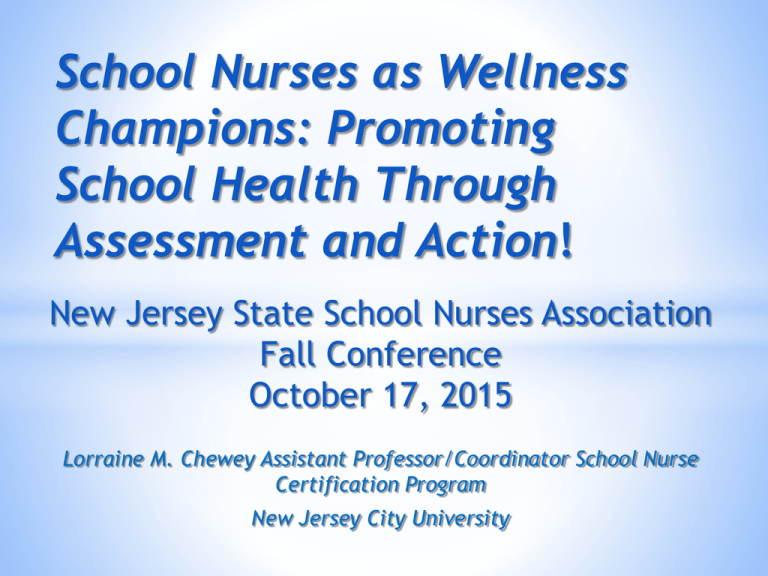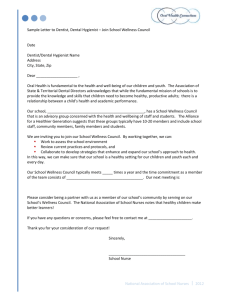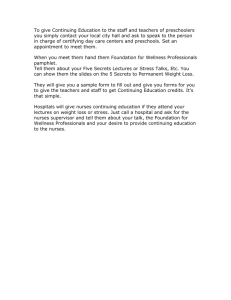School Nurses as Wellness Champions
advertisement

School Nurses as Wellness Champions: Promoting School Health Through Assessment and Action! New Jersey State School Nurses Association Fall Conference October 17, 2015 Lorraine M. Chewey Assistant Professor/Coordinator School Nurse Certification Program New Jersey City University Session Objectives At the conclusion of this educational activity, learners will be able to utilize the CDC's School Health Index Assessment & Planning tool to: *identify strengths and weaknesses of health and safety policies and programs *develop an action plan for improving student health, which can be incorporated into the District Wellness Committee and School Improvement Plan *Engage teachers, parents, students, and the community in promoting health-enhancing behaviors and better health *Establish the school nurse as the unequivocal health expert and health care leader in the school setting. *Who has time for this? *What is in it for me? *Where can I find support for school health assessment? *When is a good time to address school health assessment? *Why should school nurses be concerned with the School Health Index? *So What? *“It is the position of the National Association of School Nurses that the registered professional school nurse is the leader in the school community to oversee school health policies and programs. The school nurse serves in a pivotal role to provide expertise and oversight for the provision of school health services and promotion of health education….The school nurse serves as a liaison between school personnel, family, community and healthcare providers to advocate for health care and a healthy school environment (American Nurses Association & National Association of School Nurses [ANA & NASN], 2011).” RWJF reported that *“School nurses are on the frontlines of disease surveillance and play a critical role in containing epidemics, promoting healthy behaviors, and meeting children’s chronic and episodic health care needs” *“School nurses act as a ‘health care safety net for all children” *“School nurses are at the core of this enterprise (school health services” *“School health services as a ‘hidden system” of health care” (Dr. Julia Graham Lear, Center for Health & Healthcare in Schools, 2011) *Unlocking the Potential of School Nursing, 2010 Institute of Medicine’s (IOM) report, The Future of Nursing: Leading Change, Advancing Health (2011) recommendations: *nurses should serve actively and play more pivotal roles on boards and commissions in improving the health of all Americans. *In the health policy arena, nurses should participate in and lead health care decisionmaking…and implementation efforts *Institute of Medicine Report National coalition of health care organizations, professional nursing associations and corporate America designed to: *increase nurses’ presence on corporate & non-profit health-related boards of directors *implement a national strategy to bring nurses’ valuable perspective to governing boards, as well as state-level and national commissions, with an interest in health. *Goal: to put 10,000 nurses on boards by the year 2020. *The effort is a direct response to the Institute of Medicine’s (IOM) report, The Future of Nursing: Leading Change, Advancing Health (2011). *Supported by ANA, NLN, Sigma Theta Tau, AARP, RWJF, Jonas Center, and more. * Nurses on Boards, 2014 Increase the proportion of elementary, middle, and senior high schools that: *have a full-time registered school nurse-to-student ratio of at least 1:750; *provide school health education to promote personal health and wellness in the following areas: hand washing or hand hygiene; oral health; growth and development; sun safety and skin cancer prevention; benefits of rest and sleep; ways to prevent vision and hearing loss; and the importance of health screenings and checkups; *provide comprehensive school health education to prevent health problems in the following areas: unintentional injury; violence; suicide; tobacco use and addiction; alcohol or other drug use; unintended pregnancy, HIV/AIDS, and STD infection; unhealthy dietary patterns; and inadequate physical activity; … *HEALTHY PEOPLE 2020 *Chronic Conditions (Asthma, Diabetes, etc.…) *Attendance / Chronic Absenteeism *Obesity/Nutrition/Physical Activity *Food Insecurity / School Breakfast *Sleep *Mental Health Condition (Anxiety/Stress, Depression, Suicide, Self-Injury…) *Risk Behaviors (Alcohol, Tobacco, and Other Drug Use, STD’s, Pregnancy…) * Health Conditions Impacting Academic Performance *School Wellness Policies are federally mandated *Section 204 of the Healthy, Hunger-Free Kids Act of 2010 (Public Law 111-296) added Section 9A to the Richard B. Russell national School Lunch Act (42 USC 1758b), Local School Wellness Policy Implementation. *Each local educational agency that participates in the National School Lunch Program or other federal Child Nutrition programs is required by federal law to establish a local school wellness policy for all schools under its jurisdiction. *DID YOU KNOW?? *This bill expands the scope of local school wellness policies; brings in additional stakeholders in its development, implementation and review; and requires public updates on the content and implementation of the wellness policies. *The intent is to strengthen local school wellness policies so they become useful tools in evaluating, establishing, and maintaining healthy school environments, and to make clear to the public (including parents, students, and others in the community) about the content and implementation of local school wellness policies. *THE HEALTHY, HUNGER-FREE KIDS ACT OF 2010 * Include goals for nutrition promotion and education, physical activity, and other school-based activities that promote student wellness. * Include nutrition guidelines to promote student health and reduce childhood obesity for all foods available in each school district. * Permit parents, students, representatives of the school food authority, teachers of physical education, school health professionals, the school board, school administrators, and the general public to participate in the development, implementation, and review and update of the local wellness policy. * Inform and update the public (including parents, students, and others in the community) about the content and implementation of local wellness policies. * Be measured periodically on the extent to which schools are in compliance with the local wellness policy, the extent to which the local education agency’s local wellness policy compares to model local school wellness policies, and the progress made in attaining the goals of the local wellness policy, and make this assessment available to the public. *LOCAL SCHOOL WELLNESS POLICIES *STOP 1. How do you think your schools could benefit from completing the SHI? 2. What health topic area(s) is/are most importance to your school? Why? *Mental Health Food Insecurity *Obesity Sleep *Physical Activity Chronic Conditions *Sexual Health School Safety /Violence *Attendance/Chronic Absenteeism *Substance Use/Prevention *THINK PAIR SHARE * Contact Information Lorraine Chewey New Jersey City University lchewey@njcu/edu 201-200-2421 References Basch, C. (2010). Equity Matters: Research Review No. 6. Healthier Students are Better Learners: A Missing Link in School Reform to Close the Achievement Gap. New York: Teachers College Columbia University. http://www.equitycampaign.org/i/a/document/12557_EquityMattersVol6_Web03082010.pdf Ickovics JR, Carroll-Scott A, Peters SM, Schwartz M, Gilstad-Hayden K, McCaslin C. Health and academic achievement: Cumulative effects of health assets on standardized test scores among urban youth in the United States. Journal of School Health, 84:40-48. Institute of Medicine. (2012). Accelerating Progress in Obesity Prevention: Solving the Weight of the Nation. Washington, DC: The National Academies Press. Lear, J.G. (2007). Health at school: A hidden health care system emerges from the shadows. Health Affairs, 26(2), 409-419. doi:10.1377/hlthaff.26.2.409 National Association of School Nurses Position Statement. (2011). The Role of the School Nurse. Available at: https://www.nasn.org/PolicyAdvocacy/PositionPapersandReports/NASNPositionStatementsFullView/tabid/ 462/ArticleId/87/Role-of-the-School-Nurse-Revised-2011 Robert Wood Johnson Foundation (2010) Charting Nursing’s Future: Unlocking the Potential of School Nursing: Keeping Children Healthy, In School, and Ready to Learn. Available at: http://www.rwjf.org/content/dam/farm/reports/issue_briefs/2010/rwjf64263 US Department of Health and Human Services. Office of Disease Prevention and Health Promotion. Healthy People 2020. Washington, DC. Available at: http://www.healthypeople.gov/2020/about/default.aspx. Wang, L.Y., Vernon-Smiley, M., Gapinski, M.A., DeSisto, M., Maughan, E. , & Sheetz, A. (2014) Cost-benefit study of school nursing services. Journal of the American Medical Association Pediatrics, Published online May 19, 2014. Available at: http://archpedi.jamanetwork.com/








